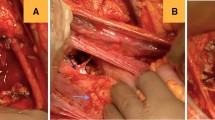Abstract
Introduction
Pancreatic metastasis of ovarian cancer is extremely rare and its therapeutic approach is not well documented. The objective of this study is to evaluate the feasibility and morbidity of pancreatic resection as a component of extensive cytoreductive surgery in epithelial ovarian cancer (EOC) patients with pancreas metastasis.
Methods
Between December 2000 and February 2003, 98 EOC patients were treated with primary cytoreduction. Six (6.12%) of these patients had pancreatic tail metastasis and were operated on using the distal pancreatectomy.
Results
Preoperatively, only 1 (16.7%) of the 6 patients had signs of metastasis to the pancreas on computed tomography (CT). Optimal cytoreduction (absent or ≤1 cm macroscopic residual tumor size) was achieved in all patients. In the early postoperative period, there were 4 patients (66.7%) with complications and no perioperative mortality. In 1 patient (16.7%), glucose intolerance as a late complication of pancreatic resection was detected. All patients received six cycles of platinum-based adjuvant chemotherapy following a cytoreductive operation. Mean follow-up was 27 months (range 9–36), and 3 (50%) patients are still alive at the end of the study period. The two-year survival rate was 66.7%.
Conclusion
In conclusion, if optimal cytoreduction is foreseen in advanced epithelial ovarian cancer with pancreatic tail metastasis, distal pancreatectomy should be kept in mind. This procedure has acceptable morbidity and seems to be an attribute for survival.

Similar content being viewed by others
References
Hiotis SP, Klimstra DS, Conlon KC, Brennan MF (2002) Results of pancreatic resection for metastatic lesions. Ann Surg Oncol 9:675–679
Nakamura E, Shimizu M, Itah T, Manabe T (2001) Secondary tumors of the pancreas: clinicopathological study of 103 autopsy cases of Japanese patients. Pathol Int 51:686–690
Pingpank JFJ, Hoffman JP, Sigurdson ER, Ross E, Sasson AR, Eisenberg BL (2002) Pancreatic resection for locally advanced primary and metastatic nonpancreatic neoplasms. Am Surg 68:337–340
Ramesh H, Philip M, Jacob G et al (2001) Isolated duodeno-pancreatic involvement due to metastatic dysgerminoma ovary and its management by a modified pancreatico-duodenal resection. Dig Surg 18:479–482
Schumacher A (1993) Delayed diagnosis of ovarian cancer with metastasis to the pancreas. Zentralbl Gynakol 115:568–569
Ferrozzi F, Bova D, Campodonico F, Chiara FD, Passari A, Bassi P (1997) Pancreatic metastases: CT assessment. Eur Radiol 7:241–245
Griffiths CT, Parker LM, Fuller AF Jr (1979) Role of cytoreductive surgical treatment in the management of advanced ovarian cancer. Cancer Treat Rep 63:235–240
Shimada M, Kigawa J, Minagawa Y et al (1999) Significance of cytoreductive surgery including bowel resection for patients with advanced ovarian cancer. Am J Clin Oncol 22:481–484
Scarabelli C, Gallo A, Franceschi S et al (2000) Primary cytoreductive surgery with rectosigmoid colon resection for patients with advanced epithelial ovarian carcinoma. Cancer 88:389–397
Slezak LA, Anderson DK (2001) Pancreatic resection: effects on glucose metabolism. World J Surg 25:452–460
Petru E, Sevin BU, Averette HE, Koechli OR, Hilsenbeck S (1991) Long-term survival in stage III and IV ovarian cancer. Arch Gynecol Obstet 249:87–93
Chen LM, Leuchter RS, Lagasse LD, Karlan BY (2000) Splenectomy and surgical cytoreduction for ovarian cancer. Gynecol Oncol 77:362–368
Guidozzi F, Jaqualine HS, Ball BS (1994) Extensive primary cytoreductive surgery for advanced ovarian cancer. Gynecol Oncol 53:326–330
Nicklin JL, Copeland RV, Lewandowski GS, Vaccanello L, Havenar LP (1995) Splenectomy as part of cytoreductive surgery for ovarian carcinoma. Gynecol Oncol 58:244–247
Bassi C, Butturini G, Molinari E et al (2004) Pancreatic fistula rate after pancreatic resection. The importance of definitions. Dig Surg 21:54–59
Sauvanet A (2002) Functional results of pancreatic surgery. Rev Prat 52:1572–1575
Adam U, Makowiec F, Riediger H et al (2001) Distal pancreatic resection: indications, techniques, and complications. Zentralbl Chir 126:908–912
Blythe JG, Wahl TP (1982) Debulking surgery. Does it increase the quality of life? Gynecol Oncol 14:396–400
Todo Y, Sakuragi N, Oikawa M et al (2003) Cytoreductive surgery combined with organ resection for advanced ovarian carcinoma. Int J Clin Oncol 8:90–96
Author information
Authors and Affiliations
Corresponding author
Rights and permissions
About this article
Cite this article
Yildirim, Y., Sanci, M. The feasibility and morbidity of distal pancreatectomy in extensive cytoreductive surgery for advanced epithelial ovarian cancer. Arch Gynecol Obstet 272, 31–34 (2005). https://doi.org/10.1007/s00404-004-0657-3
Received:
Accepted:
Published:
Issue Date:
DOI: https://doi.org/10.1007/s00404-004-0657-3




